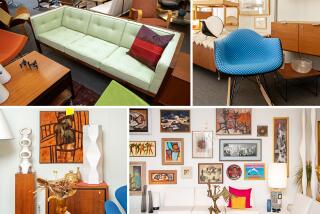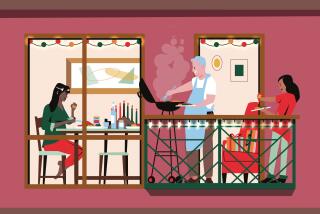Pressing Subject Has Gotten More Convenient Over Years
- Share via
Imagine lifting a 5-pound heated iron to press your clothes. In past centuries, fabric was smoothed with the help of irons heated by burning charcoal or inserts of heated metal (called slugs), or by irons that were placed directly on a hot stove.
Each method had a drawback. Burning charcoal could emit sparks; slugs would rust because of the moisture of the clothes; and electric irons still have annoying cords. Most irons were made of cast iron or bronze.
Designers have tried for centuries to make the perfect iron. In the 20th century, some ran on kerosene; others shot steam on the clothes. Some were even made of heat-proof glass.
Collectors searching for rare, 200-year-old irons find most of them for sale in Europe. One of the earliest irons still in existence was sold recently. It was made in France at the end of the 1400s.
The flatiron was decorated with cutout flowers, and it had a wooden handle. (Some 19th century irons had iron handles that were wrapped in a cloth when the heated iron was used.)
It was sold for $11,508 by Auction Team Koln of Germany.
*
Question: I have a small, tin store display for Eveready batteries and flashlight bulbs. The batteries are still in the display case. Is it worth saving?
*
Answer: Any piece of old advertising is worth saving. Store displays are prized by some collectors. Your store display probably dates from the 1920s or ‘30s. If it is in good condition, it would sell for about $100.
*
Q My grandmother has a framed Currier & Ives print titled “Central Park--The Bridge.” How can I tell whether it is a reproduction or an original?
*
A Reproductions of 19th century Currier & Ives original lithographed prints have been made for decades. There are clues that help distinguish an original Currier & Ives lithographed print from a reproduction.
Remove the frame and measure the print. An original “Central Park--The Bridge” is small. It measures 8 inches by a little under 13 inches. If the wording under the print includes the word “reprinted,” you’ll know it is not an original lithographed print made from a drawing on a stone.
Examine the picture under a magnifying glass. Color reproductions are done by a photographic process that breaks colors into a pattern of tiny dots. If you see tiny dots under the glass, you have a reprint. Originals are on heavy paper; reprints are usually on thinner, less absorbent paper. Most originals were lithographed in black and white and colored by hand.
All of these tips should be helpful. If you are still concerned, take the print to a specialized dealer or a museum curator. It is best to get advice from an expert who can look at your print.
*
Q My family heirloom silver teakettle has a matching base that holds some sort of candle or fuel to heat the tea. Does that help to tell its age?
*
A Teakettles with heaters, or what are called lamp bases, were made as early as 1690. They are still being made. The only fuels available for the earliest kettles were spirits of wine or several fuels with unpleasant odors.
By 1765, teakettles or tea urns were heated with small charcoal burners. Some of the kettles had an interior tube that held a preheated iron rod. By the 1840s, an easy-to-use, odorless fuel was developed, and heated tea and coffeepots were back in style. Today the beverage is kept warm with an electric burner or in an air pot.
*
Q When my parents vacationed in Niagara Falls many years ago, they brought home a fabric heart sewn with large, clear beads. They told me the heart was sold by Indians.
*
A Pre-1900 American Indian beadwork clothing and moccasins have gone up in price as the supply has dwindled and the demand has grown. Your beaded heart is one of many “whimsies” made by the Iroquois of upstate New York since the late 1800s.
Many like yours were sold as souvenirs at Niagara Falls.
Other types of whimsies include pincushions, picture frames, small purses and various Indian-related shapes, such as boots, canoes, arrowheads and hexagons. The most valuable whimsies date from the 19th century and are beaded on purple velvet. Your whimsy probably dates from the 20th century and is worth about $20.
*
Q My 19th century ceramic covered jar is decorated with flowers. It is 5 inches tall and has a hole in the bottom. The people I’ve asked about its original use disagree. Some say it’s a jam jar, and others argue that it was made to hold a can of condensed milk. Do you know?
*
A If the cover has no notch for a spoon, and if the painted decoration on the outside does not include fruit, your jar was probably made to hold a can of condensed milk. By the end of the 19th century, canned condensed milk was sold to be used on cereal or fruit, or as cream for coffee. Milk producers sometimes offered ceramic condensed-milk holders as product premiums.
For a listing of helpful books and publications, include a self-addressed, stamped (55 cents) envelope to Kovels, Los Angeles Times, King Features Syndicate, 235 E. 45th St., New York, NY 10017.
(BEGIN TEXT OF INFOBOX / INFOGRAPHIC)
Current Prices
Current prices are recorded from antique shows, flea markets, sales and auctions throughout the United States. Prices vary in different locations because of local economic conditions.
* Pepsi-Cola Tasmanian Devil glass, 1973, 16-ounce, $15.
* Hall teapot, windshield pattern, maroon with gold trim, six-cup capacity, $35.
* Bottle opener, drunk in tuxedo leaning against lamppost, souvenir of Weston, W.Va., $55.
* Barbershop pole, electric, spinning, cast-iron mounting bracket, red, white and blue, circa 1940s, 25 1/2 by 8 inches, $225.
* Ideal Patty Playpal doll, honey-blond wig, original dress, 1960, 35 inches, $300.
* Sterling silver flatware, fish serving fork, Imperial Chrysanthemum pattern, by Gorham, 8 1/2 inches, $310.
* Watt baker, cover, tulip pattern No. 600, $380.
* Hans J. Wegner “Papa” chair, brown wool-upholstered, winged back, cantilevered arms, teak dowel legs, 24 by 20 by 33 inches, $1,265.
* Figural bitters bottle, ear of corn, National Bitters, deep strawberry puce, patent 1867, 12 1/2 inches, $2,035.
* Ty Cobb single signed baseball, Official Little League ball, off-white, green ink, dated May 21, 1961, $2,530.
More to Read
Sign up for The Wild
We’ll help you find the best places to hike, bike and run, as well as the perfect silent spots for meditation and yoga.
You may occasionally receive promotional content from the Los Angeles Times.






